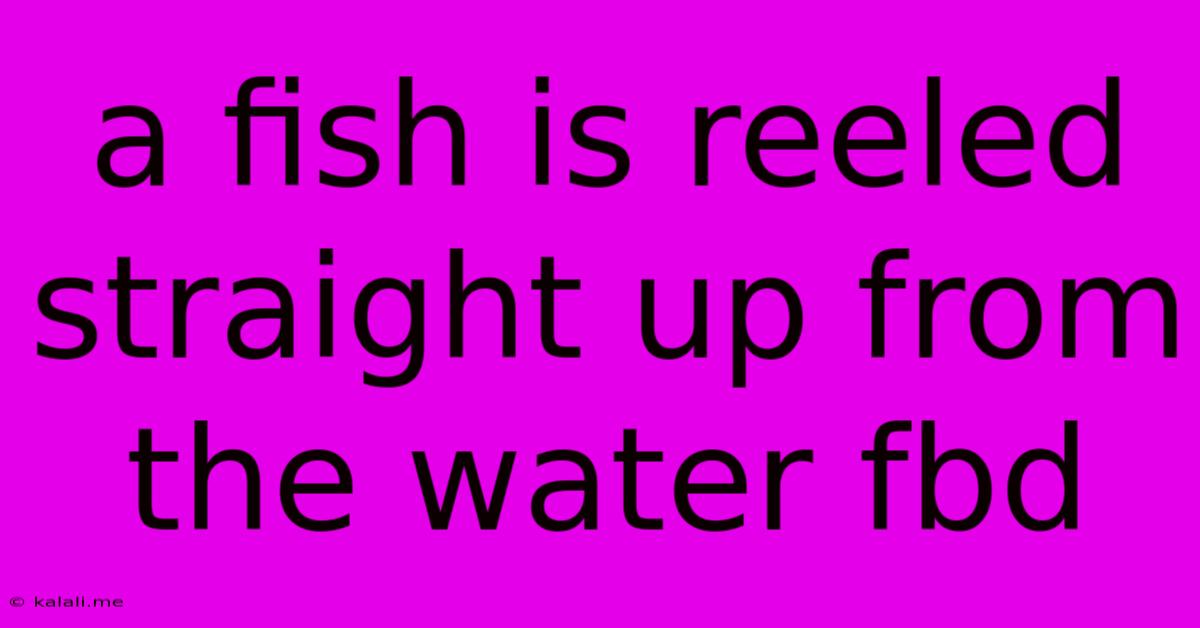A Fish Is Reeled Straight Up From The Water Fbd
Kalali
May 18, 2025 · 3 min read

Table of Contents
A Fish Reeled Straight Up: A Free Body Diagram Analysis
This article delves into the physics behind reeling a fish straight up from the water, using a free body diagram (FBD) to analyze the forces involved. Understanding these forces is crucial for anglers to successfully land their catch and to appreciate the interplay of physics in this common activity.
What is a Free Body Diagram?
A free body diagram is a visual representation of an object and all the forces acting upon it. By isolating the object and showing only the forces, we can easily analyze the net force and predict the object's motion. In this case, our object is the fish.
Forces Acting on the Fish
Several forces act on the fish as it's reeled upwards:
-
Weight (W): This is the force of gravity acting downwards on the fish's mass. It's calculated as W = mg, where 'm' is the fish's mass and 'g' is the acceleration due to gravity (approximately 9.8 m/s²).
-
Tension (T): This is the upward force exerted by the fishing line on the fish. This force is directly related to the force applied by the angler to the fishing rod.
-
Buoyancy (B): This is the upward force exerted by the water on the fish. Archimedes' principle dictates that the buoyant force is equal to the weight of the water displaced by the fish. The magnitude of this force depends on the fish's volume and the density of the water.
-
Drag (D): This is the resistance force of the water against the fish's movement through it. Drag is a complex force dependent on the fish's shape, size, speed, and the water's viscosity. As the fish is reeled upwards, the drag force acts downwards.
The Free Body Diagram
The FBD would show the fish as a point mass with four arrows representing the forces:
- An arrow pointing downwards labeled 'W' (Weight)
- An arrow pointing upwards labeled 'T' (Tension)
- An arrow pointing upwards labeled 'B' (Buoyancy)
- An arrow pointing downwards labeled 'D' (Drag)
Analyzing the Forces and Fish Motion
The net force acting on the fish is the vector sum of all these forces. If the upward forces (Tension + Buoyancy) are greater than the downward forces (Weight + Drag), the fish will accelerate upwards. If the downward forces are greater, the fish will accelerate downwards. If the forces are balanced, the fish will move upwards at a constant velocity.
Factors Influencing the Reeling Process
Several factors influence the forces and, therefore, the success of reeling in the fish:
- Fish Size and Weight: A larger, heavier fish will require more tension to reel in.
- Water Depth and Current: Deeper water and stronger currents increase the drag force.
- Fishing Line Strength and Type: The fishing line's strength determines the maximum tension it can withstand before breaking.
- Angler's Technique: The angler's skill in applying a consistent and appropriate tension is crucial.
Conclusion
Reeling a fish straight up from the water is a dynamic process governed by a complex interplay of forces. By understanding these forces and creating a free body diagram, anglers can gain valuable insights into the physics behind this activity and improve their angling techniques. This analysis highlights the importance of factors such as fish weight, water resistance, and line tension in a successful fishing experience. Further analysis could involve calculating the acceleration of the fish, factoring in varying water densities and drag coefficients for a more complete understanding.
Latest Posts
Latest Posts
-
I Mixed Green And Orange Coolant What Should I Do
Jun 01, 2025
-
How Long Does A Toilet Last
Jun 01, 2025
-
App For Windows 11 Internet Connection Monitor In Taskbar
Jun 01, 2025
-
How To Get Cat Urine Out Of Hardwood Floors
Jun 01, 2025
-
Do With This What You Will
Jun 01, 2025
Related Post
Thank you for visiting our website which covers about A Fish Is Reeled Straight Up From The Water Fbd . We hope the information provided has been useful to you. Feel free to contact us if you have any questions or need further assistance. See you next time and don't miss to bookmark.